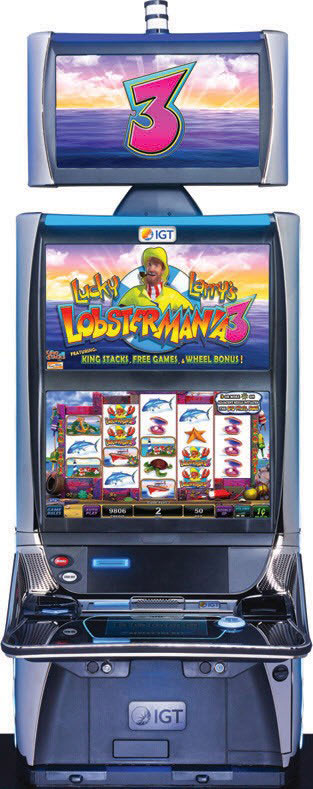BACK TO BASICS
The mechanical reel-spinning slot machine continues to prove itself popular with players
By Frank Legato
 For a century, the perception of what constituted a slot machine remained the same— three physical spinning reels, a simple pay schedule displayed on the front with bar symbols, 7s and fruit symbols.
For a century, the perception of what constituted a slot machine remained the same— three physical spinning reels, a simple pay schedule displayed on the front with bar symbols, 7s and fruit symbols.
Certainly, changes were made along the way to enhance the game. Slot handles gave way to spin buttons. (Some still like the handles, but these days, all handles do is hit an internal spin button.) Coins gave way to bill acceptors and credit play, eliminating the coin slot—which was the origin of the term “slot machine.” Ticket in/ticket out operation made credit play even easier. Single paylines gave way to games with three, five or nine paylines.
But mechanical spinning reels and simple pay schedules remained at the core of the slot machine. Then, in the mid-1990s, a new type of slot machine began to take hold, first with so-called “Australian-style” video slots, with their poker symbols (they’re still called “pokies” in Australia), encyclopedic pay schedules, and paylines that began with nine and evolved to 45 lines, even 100 lines.
Then there were the bonus events. Reel-symbol triggers would enact a “game within a game”—a picking event, or a second-screen event related to the theme of the slot machine. Though these secondary bonus events may have originated with the Australian pokies, U.S. slot manufacturers quickly jumped on the bandwagon with themed bonuses. The mechanical reelspinners would start, with games like Wheel of Fortune and its venerable roulette-style bonus wheel. Other reel-spinners would follow suit, but video slots were the venue where elaborate themed bonus events would reach their apex.
For U.S. manufacturers, it started with the WMS game Reel ’Em In. The second-screen bonus depicted fishermen (and fisherwomen) on a lake, making hilarious wisecracks with Chicago accents (WMS was located in Chicago) as they dropped their lines into the water, “fishing” for bonuses. IGT would soon follow with games like Lucky Larry’s Lobstermania and its funny “Buoy Bonus,” and soon, animated bonus features were all the rage.
By the early 2000s, the popular culture themes in video slots were everywhere, as were bonuses that followed the theme. The Beverly Hillbillies. Gilligan’s Island. Playboy. Betty Boop. Popeye. MAS*H. Around the same time, many casino industry pundits began predicting that the rise of popular video slots would soon result in the demise of traditional mechanical reel-spinners.
Seriously. Professionals who I had known since the 1980s were predicting that mechanical reel- spinners would be extinct by 2010. I never believed them. Part of my opinion was due to the fact that, despite all the new elaborate bonuses and comical animated sequences, mechanical reel- spinners were the style of game to which I always returned.
After all, how many times do you laugh at a joke that keeps repeating itself? How many times do you look at a bonus drawing on a TV show you love before it becomes tiresome? That’s one reason most of those games have disappeared. In the end, slot machines are about gambling and winning money.
That’s what the reel-spinners are all about—working to beat the house edge by bankrolling your game, searching for that big payoff.
Well, it looks like I was right after all. Gilligan’s Island, Pop-eye—those are the games that are now extinct. The reel-spinners— Wheel of Fortune, Double Diamond, Top Dollar, Quick Hit—those are the games that have survived.
Many of the slot manufacturers eventually realized that this genre of game was still wildly popular, and that the reel-spinning market had been underserved for years. What we’ve seen in recent years is a rededication by the slot-makers of resources to create new mechanical reel-spinners that played just like the traditional games but offered all the modern amenities. IGT and Light & Wonder— the former Bally—have launched new reel-spinning cabinets that painstakingly duplicate all the basics of the classic game, but with modern perks like player-selectable denominations, onboard cellphone charging and more. This year, Light & Wonder even rolled out a new version of the classic hit Blazing 7s.
Other manufacturers have begun to serve the traditional slot player. Everi, for instance, has mastered the art of the mechanical reel-spinner with games like Triple Jackpot Gems, Blazin’ Gems Deluxe and my personal favorite, Rocky & Bullwinkle. In fact, Everi is already on its second generation of reel-spinning cabinets. Aristocrat has its RELM series of mechanical reel-spinners. Ainsworth duplicates the classic reel-spinning experience with simple, high-denomination three-reel video slots.
These new-age mechanical reel-spinners implement technology that sets them apart, managing to use that technology to bring former video-only perks like free spins and cash-on-reels to the reelspinning genre. IGT just launched its DiamondRS reel-spinning cabinet, which features a new generation of transmissive reels technology called “Diamond Glass.” It allows a reel-spinner to employ special watermarks on reel symbols to multiply payouts, and allows multiple payline configurations on the same cabinet. Everi’s new Player Classic Signature cabinet also gives players the ability to select payline configurations.
Meanwhile, the slot-makers continue to roll out new versions of legendary reel-spinners. IGT’s Wheel of Fortune continues to reinvent itself with new versions. Light & Wonder’s Quick Hit series continues to roll out new games in the simplified progressive setup.
Yes, the video slot has evolved, with both popular culture themes like Game of Thrones and proprietary themes like Buffalo— and yes, Lucky Larry—implementing new game mechanics like hold-and-spin, expanding reels and multiple progressives.
But as Mark Twain may have said, it turns out that reports of the death of the spinning reel were greatly exaggerated.
Told you.


